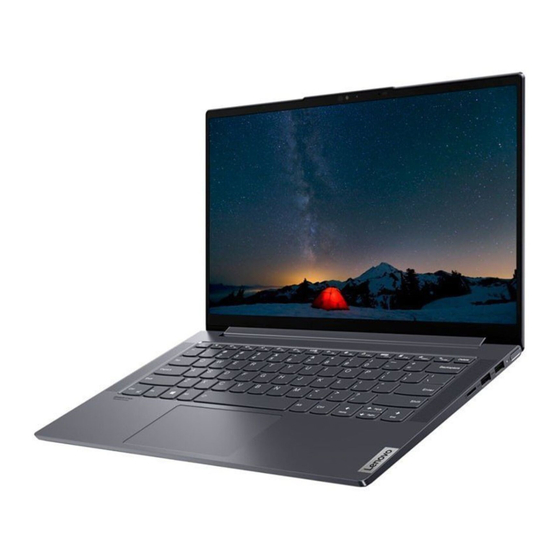
Table of Contents
Advertisement
Quick Links
Advertisement
Table of Contents

Summarization of Contents
Meet your PC
Top view
Identifies components visible on the top of the PC, including antennas and keyboard.
Antennas
Transmit and receive radio waves for Wi-Fi and Bluetooth connectivity.
Keyboard
Built-in input device for typing characters and productive interaction.
Speakers
PC's built-in sound output devices.
Touchpad
Built-in pointing device for screen navigation and interaction.
Front view
Details components located on the front of the PC, such as cameras and sensors.
Infrared camera
Receives near-infrared waves for facial recognition.
Camera
Captures visible light for video recording and conferencing.
IR LED
Emits near-infrared waves for facial recognition.
Color sensor
Detects ambient light intensity for adaptive brightness/color.
Camera light
Indicates camera activation status.
Microphones
Capture voice and ambient sound for input.
Screen
Displays text, graphics, and videos; touch-enabled.
Left view
Identifies ports and indicators on the left side of the PC.
Multi-purpose USB Type-C connector
Power input and connection for peripherals/displays.
Charging light
Indicates PC charging status and battery level.
Right view
Details components and ports on the right side of the PC.
Power button
Used to turn on the PC or put it into sleep mode.
Power light
Indicates PC power state and battery level.
Camera switch
Enables or disables the built-in camera for privacy.
Multi-purpose USB Type-C connector
Power input and connection for peripherals/displays.
Bottom view
Identifies features on the bottom of the PC, such as vents and buttons.
Air vents (intake)
Allow air circulation for cooling internal components.
Novo button hole
Recessed hole for accessing the Novo button menu.
Specifications
Technical details of the PC's dimensions, power, memory, etc.
Statement on USB transfer rate
Explains factors affecting actual USB data transfer speeds.
Operating environment
Specifies temperature, altitude, and humidity limits for operation.
Explore your PC
Your PC and its operating system
Overview of the OS, its management of hardware, and utilities.
Initial setup of the Windows operating system
Steps for setting up the OS, creating accounts, and connecting to networks.
Set up facial recognition
Enables facial recognition for Windows login using IR camera.
Windows Update
Information on receiving and installing system and driver updates.
Windows recovery options
Discusses methods to restore the PC to a previous state.
Use power efficiently
Tips and settings for optimizing PC power consumption.
Shut down your PC
Procedure to completely turn off the computer.
Put your PC into sleep mode
Procedure to enter low-power sleep mode.
Adjust timeouts for sleep and the built-in screen
Configures when the screen or PC enters power-saving modes.
Switch the PC's active power mode
Allows selection between performance and power-saving modes.
Enable presence sensing
Activates screen auto-off/wake based on user proximity.
Set up Internet access
Guides on connecting to Wi-Fi networks.
Interact effectively with your PC
How to use PC input/output devices and external connections.
The display device
Details on the built-in and external display connections.
Touch screen gestures
Explains various single and multi-finger touch gestures.
Enable adaptive color and brightness
Uses color sensor for automatic display adjustments.
Adjustable display refresh rate
How to change screen refresh rate for smoother visuals.
Turn on night light
Activates warmer screen colors to reduce eye strain.
Adjust color temperature
Modifies screen color temperature for comfort.
Connecting external displays
Options for connecting monitors via USB-C.
Direct connection
Connecting displays directly via USB-C.
Connection using an adapter
Using adapters for DisplayPort/HDMI connections.
Connection using a docking station
Expanding connectivity via USB4/Thunderbolt docks.
Keyboard
Overview of keyboard functions and keys.
Shortcut keys
General categories of shortcut keys available.
Hotkeys
Function keys with secondary actions indicated by icons.
The FnLock switch
Toggles Fn key behavior between primary and secondary functions.
Combination keys using the fn key
Key combinations involving the Fn key for system control.
Combination keys using the Windows logo key
Key combinations using the Windows key for shortcuts.
The Copilot key
Dedicated key for accessing AI assistant or other functions.
Touchpad gestures
Navigating the system using touchpad gestures.
Multi-finger touchpad gestures
Specific multi-finger gestures and their functions.
Modify the default functions for touchpad gestures
Customizing touchpad gesture actions in settings.
Bluetooth connectivity
Connecting Bluetooth devices to the PC.
Connect a Bluetooth-enabled device to your PC
Step-by-step guide to pairing Bluetooth devices.
The firmware of your PC
Explanation of the PC's firmware and its boot process.
The utility program for the PC's firmware
Accessing and using the firmware setup utility.
Set passwords in the firmware setup utility
Securing access to firmware or storage with passwords.
Password types
Overview of available password types (Admin, User, HDD).
Set administrator password
Creating an administrator password for firmware access.
Change or remove administrator password
Procedures for modifying or deleting administrator passwords.
Set user password
Creating a user password for firmware access.
Enable power-on password
Enforcing password entry at system startup.
Set passwords for the mass storage device
Setting passwords for hard disk protection.
Change or remove passwords for the mass storage device
Modifying or removing hard disk passwords.
Help and support
Frequently asked questions
Common issues and their solutions.
What should I do if my computer stops responding
Steps to take when the PC becomes unresponsive.
What should I do if I spill liquid on the computer
Emergency steps after liquid spills on the PC.
Why does my computer start automatically when I open the lid
Explains the 'Flip to Start' feature and its configuration.
Self-help resources
Links and guides for troubleshooting and information.
What is a CRU?
Defines Customer Replaceable Units and their types.
CRUs for your product model
Lists specific CRUs for the product model.
Call Lenovo
Instructions for contacting Lenovo support.
Before you contact Lenovo
Information to gather before contacting support.
Lenovo Customer Support Center
Details about the support center and services.
Purchase additional services
Information on buying extended warranty or services.
Notices and trademarks
Notices
Legal disclaimers, warranty information, and usage rights.
Trademarks
Lists registered trademarks of Lenovo and other companies.








Need help?
Do you have a question about the 83ED and is the answer not in the manual?
Questions and answers